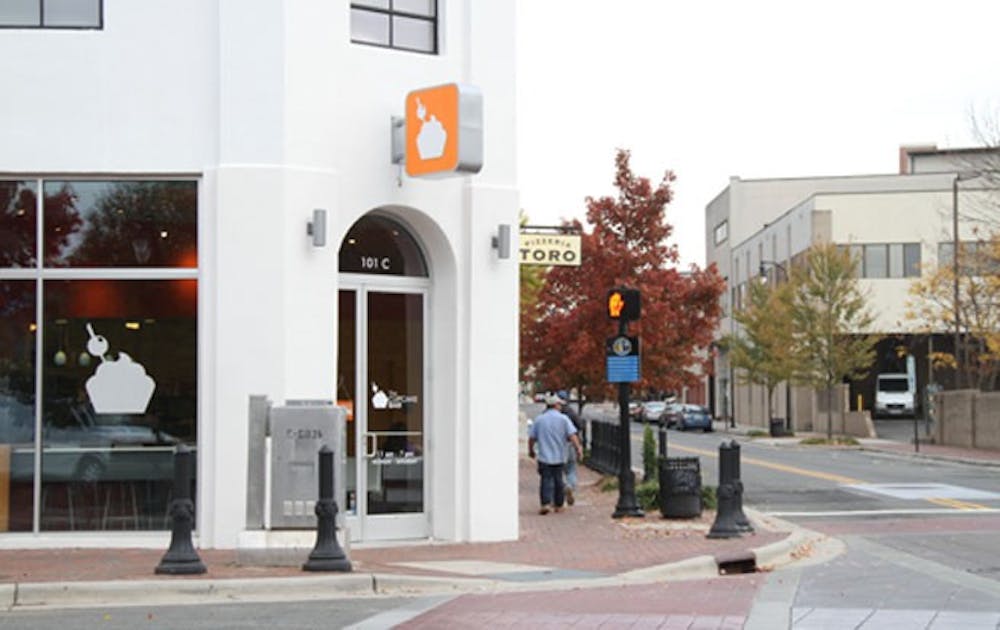Claiming that Durham “doesn’t have much to offer” can be a self-fulfilling prophecy if you only extend yourself to the bars on Main Street. But the city, which can at times feel disconnected from Duke, houses a number of establishments that students can take advantage of. The revival of downtown Durham continues with a new wave of openings at Five Points, the intersection of Chapel Hill Street, Morris Street and Main Street. Three local businesses—Bullseye Bicycle, The Cupcake Bar and Pizzeria Toro—located in the 102 Morris building, are helping to reinvigorate the area.
Over 100 years old, the building was, until recently, condemned after roof and sewage leakage posed safety hazards. Yet under Durham architect Scott Harmon’s direction, the area is now an exciting place to go downtown. Pizzeria Toro and The Cupcake Bar are especially attracting new customers and contributing to Durham’s “foodie” reputation.
“I think it is having a big impact on the Durham community,” said Anna Branly, co-owner, along with her sister Katie Braam, of The Cupcake Bar. “The space has been underutilized for so long. Now people have stopped by and thanked us for doing this.”
Looking out of the lower level’s glass façade, you can see people walking around the Five Points area, a sight that Gray Brooks, co-owner of Pizzeria Toro, said you would not have seen five years ago. Brooks, who worked as a sous-chef under restaurateur Tom Douglas in Seattle before returning to his hometown of Durham, hinted at the city’s changing history.
“ I remember in high school, those were some really rough times,” he said. “Durham is finally waking up.”
In the 1980s, the renovation and transformation of the tobacco warehouses around Brightleaf Square marked the beginning of the revival movement, but past Brightleaf, the gentrification boom slowed down. Recently, renovations of historic buildings have revitalized other areas like Five Points, once the geographic and social center of town. The 102 Morris building, built between 1893 and 1901, is one the oldest buildings in Durham, but due to its modernization in the ‘50s, it no longer retains much of the architectural elements of that time period, such as the Empire roof, arched windows and brick façade.
Prior to the renovation, some “points” of the Five Points area were neglected and hardly frequented. Now, the renovation creates a “double-loaded corridor” in which businesses exist on both sides of the streets, enhancing pedestrians’ downtown experience.
In addition to the many restaurants in the area, retail is becoming a growing sector of downtown business. Tyler Kober, owner of Bullseye Bicycle, said, “We are trying to be one of the first anchoring retail stores in downtown Durham.”
Despite their unique trades, the building’s occupants all share the risk of being a first-time business owner. Brooks, working as a chef at a gourmet pizzeria in Seattle, brought his skills back to his hometown. Kober, after working at bike shops since he was 15—most recently at the Bike Chain in Chapel Hill—finally decided to open his own place. Branly and Braam, who started their delivery-only cupcake business in 2008, sought out a brick-and-mortar location.
In 2011, Harmon, of Center Studio Architecture, proposed a plan to the city of Durham that would undertake renovations to the building; he envisioned three businesses on the first floor and three condominiums upstairs. To help finance the project, Harmon first had to find business owners and residents prior to construction.
Attracting financiers for the project was a community effort. Harmon used local ties to attract potential buyers and gave them the opportunity to invest in the project.
“One of the main reasons we chose this spot was because we could buy,” said Branly. “It’s worth it in the long run.” As Kober mentioned, the businesses are not at the whim of a landlord who could raise the rent when the area picks up.
But economic reasons were not the sole incentive. Brooks said, “I’ve always had a soft spot for this building.”
The renovations did not come without difficulty. The whole building had to be gutted—all of the plumbing, electrical and heating systems were replaced and The Cupcake Bar and Pizzeria Toro specifically built kitchens tailored to their establishments. Harmon, however, preserved some historical aspects. For example, the original concrete floors still remain unfinished; for his pizzeria, Brooks recycled some of the wood for tabletops. And for The Cupcake Bar and Bullseye, Harmon removed the old ceilings, reconditioned them offsite, and installed them once again. The synthesis of past and modern design reminds us of the rich history of the building and its continual progress.
Branly said, “Of course it was a difficult process, but if you want to have a place downtown, you have renovate. There aren’t any renovated spaces open for lease.”
The Five Points area revival is just another example of how Durham is “waking up.” Duke consistently contributes to Durham’s growing infrastructure, an effort that speaks to the university’s goal of using Durham as another selling point for Duke. As Kober describes it, “Downtown is becoming cooler and cooler.”
Get The Chronicle straight to your inbox
Signup for our weekly newsletter. Cancel at any time.

